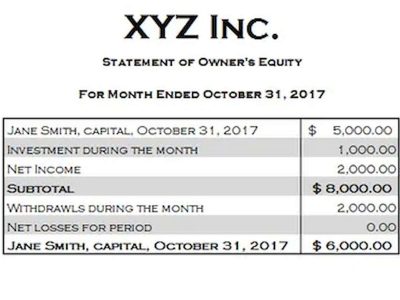
It is also a long-term risk assessment of the capital structure of a company and provides insight over time into its growth strategy. For mature companies consistently profitable, the retained earnings line item can contribute the highest percentage of shareholders’ equity. In these types of scenarios, the management team’s decision to add more to its cash reserves causes its cash balance to accumulate.

Types of Private Equity Financing
However, you can use both formulas to calculate equity for shareholders equally well. As a business owner and entrepreneur, you need to know how equity affects your enterprises and how to calculate it for your shareholders, mainly before you go public. This article will discuss total equity formula how to calculate equity for shareholders in detail. Understanding Total Equity is fundamental for anyone involved in financial investment or corporate finance. It’s a key marker of a company’s financial health and can provide valuable insights into investment decision-making.
Read a balance sheet
- Equity can be found on a company’s balance sheet and is one of the most common pieces of data employed by analysts to assess a company’s financial health.
- Since equity accounts for total assets and total liabilities, cash and cash equivalents would only represent a small piece of a company’s financial picture.
- In this case, it’s just the value of all your assets (cash, equipment, etc.) minus all your liabilities .
- If a company’s D/E ratio is too high, it may be considered a high-risk investment because the company will have to use more of its future earnings to pay off its debts.
- Shareholders’ equity can also be calculated by taking the company’s total assets less the total liabilities.
- Stockholders’ equity is equal to a firm’s total assets minus its total liabilities.
- Since we’ve calculated the equity value of Tesla (TSLA), we’ll now repeat the process for Ford (F), General Motors (GM), and Stellantis (STLA).
Owning stock in a company gives shareholders the potential for capital gains and dividends. Owning equity will also give shareholders the right to vote on corporate actions and elections for the board of directors. These equity ownership benefits promote shareholders’ ongoing interest in the company.
How to calculate equity for shareholders
The mistake of neglecting a company’s potentially dilutive securities—i.e. By measuring the value of a company’s common equity, a practitioner can analyze the current valuation of its total shares outstanding on a diluted basis. Ratios such as return on equity, or ROE (the company’s net income divided by shareholder equity), can be used to measure how well the management team for a company uses equity from investors to generate a profit. ROE can tell investors how capable current executives are at taking investment cash and turning it into more money. If the company was liquidated, and its assets turned into $3 million, you would use some of that money to pay off the $1.2 million in liabilities.

What Is Equity and How Do You Calculate It for Shareholders? Here’s What You Need to Know.
Of the 50.4 million shares authorized, the company had issued roughly 15.5 million shares. As such, many investors view companies with negative equity as risky or unsafe. However, many individuals use it in conjunction with other financial metrics to gauge the soundness of a company. When it is used with other tools, an investor can accurately analyze the health of an organization.
AccountingTools
From the viewpoint of shareholders, treasury stock is a discretionary decision made by management to indirectly compensate equity holders. Next, the “Retained Earnings” are the accumulated net profits (i.e. the “bottom line”) that the company holds onto as opposed to paying dividends to shareholders. When companies issue shares of equity, the value recorded on the books is the par value (i.e. the face value) of the total outstanding shares (i.e. that have not been repurchased). Under a hypothetical liquidation scenario in which all liabilities are cleared off its books, the residual value that remains reflects the concept of shareholders equity. Examining the return on equity of a company over several years shows the trend in earnings growth of a company.
Retained Earnings Calculation Example (RE)

Every company has an equity position based on the difference between the value of its assets and its liabilities. A company’s share price is often considered to be a representation of a firm’s equity position. Investors contribute their share of paid-in capital as stockholders, which is the basic source of total stockholders’ equity. The amount of paid-in capital from an investor is a factor in determining his/her ownership percentage. These earnings, reported as part of the income statement, accumulate and grow larger over time.
Your business’ board of directors can issue shares whenever, to whomever, and for whatever value it wants. When your company incorporates, it has to call a board meeting to decide how many shares each of the company’s original owners will get. Shares are small pieces of your company that are worth a certain dollar value.
- These metrics include share price, capital gains, real estate value, the company’s total assets and other vital elements of private companies.
- Equity, as we have seen, has various meanings but usually represents ownership in an asset or a company, such as stockholders owning equity in a company.
- For instance, if Company A has $50,000 in cash and $70,000 in short-term debt, which means that the company is not well placed to settle its debts.
- 11 Financial’s website is limited to the dissemination of general information pertaining to its advisory services, together with access to additional investment-related information, publications, and links.
- Total Equity (TE) is the value remaining for shareholders after deducting liabilities from assets.
- An alternative calculation of company equity is the value of share capital and retained earnings less the value of treasury shares.
- On the balance sheet, shareholders’ equity is broken up into three items – common shares, preferred shares, and retained earnings.
- For example, Company A has quick assets of $20,000 and current liabilities of $18,000.
- However, you can use both formulas to calculate equity for shareholders equally well.
- Treasury shares continue to count as issued shares, but they are not considered to be outstanding and are thus not included in dividends or the calculation of earnings per share (EPS).
The quick ratio measures the capacity of a company to pay its current liabilities without the need to sell its inventory or acquire additional financing. For instance, a company with $200,000 in cash and marketable securities, and $50,000 in liabilities, has a cash ratio of 4.00. This means that the company can use this cash to pay off its debts or use it for other purposes. If a company’s D/E ratio is too high, it may be considered a high-risk investment because the company will have to use more of its future earnings to pay off its debts. When it comes to choosing whether to finance operations via debt or equity, there are various tradeoffs businesses must make, and managers will choose between the two to achieve the optimal capital structure. For example, asset-heavy industries such as utilities and transportation tend to have higher D/E ratios because their business models require more debt to finance their large capital expenditures.
- And finally, it can be used by suppliers to see if a business has accumulated a sufficient amount of equity to warrant being extended credit.
- We can calculate average total equity by using formula of total equity value at the end of the current year plus total equity value at the end of the previous year and then divide the result by two.
- The principal payment and interest expense are also fixed and known, supposing that the loan is paid back at a consistent rate.
- It can help you manage bill pay, track vendor payments, and maintain cash flow.
- The fundamental accounting equation states that the total assets belonging to a company must always be equal to the sum of its total liabilities and shareholders’ equity.